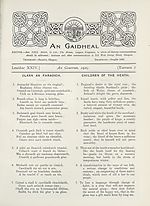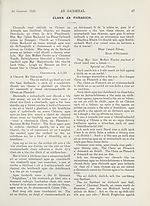An Comunn Gàidhealach Publications > Gaidheal > Volume 24, October 1928--September 1929
(74) Page 66
Thumbnail gallery: Grid view | List view

66
AN GAIDHEAL.
An Gearran, 1929.
8. lonnsaich cainntean ullamh ealamh, 8.
lomchuidh airson leas ar linn ;
Cuime dheanadh cosnadh chanain
Lochd do d’ theanga mhathrail bhinn ?
9. A1 a’ fhraoicb ge fad air fogradh
Feadh gacb fonn’s an dealraicb grian,
Chi iad fraoch nam beann am bruadar,
Gleann an gaoil that cuantan cian.
10. lonndrain cridhe ciall na h-aisling,
Earail chitlin o chadal seimh—
Cleachd do chainnt gu duineal dileas,
Snaim ri fuil is tlr is treubh.
11. A chion bidh mar arach beatha
Basuichidh gach duil tha bed ;
A chion cleachdaidh crlonaidh canain,
Seacaidh sios gun dail a deo.
12. Gabhaim gach loinn o laimh coigrich,
Cainnt is oilcan, conn is cedi;
Ni an coigreach tuigseach tarcuis,
Thuit mo chor an alt’s an edl.
13. Cdir-bhreith a chall call mo chanain;
Cunntaim sin mar ni nach fiu
Bidh mi suarach an suil coigrich;
Diult an uaill nach coisinn cliu.
14. Badan fraoich mar theisteas bdidean,
Beart a dh’ agras cli is cruas—
Cuirm no comunn, mod no margadh,
Cumaibh sedl bhur seanchais suas.
15. Sgriobh is leugh is labhair Gaidhlig,
Grunndail gaisgeil lagh nan laoch,
Deidh is dedin gu seasamh canain
Ddigh na dream d’ am fabhar fraoch.
16. Facal suaicheantais nam fiiiran,
Foighidinn, le reachd is rian ;
Furtachd is fdir, glic an gealladh,
Trie an tdir air dealas dian.
N.R.
Do thou master languages quickly and
thoroughly, fit for the requirements of
our times ; but why should the learning
of other forms of speech do harm to
thy sweet mother tongue.
9. Children of the heath, though scattered
in exile, through every land where the
sun shines, behold the mountain heather
in their dreams, the glen they love
beyond the wide seas.
10. A yearning of the heart, is the meaning of
their vision, a quiet reminder in gentle
sleep—use thy language bravely and
faithfully, a tie that binds thee to thy
race and land.
11. For lack of food to nourish life all creatures
on earth must die ; for lack of use a
language perishes, its vigour speedily
declines.
12. If I receive all my accomplishments from
a stranger’s hand, my speech and culture,
my taste and music, the intelligent
stranger must secretly despise; my
status is lowered in mental dignity and
resource.
13. To lose my language is to lose my birth¬
right ; and if I count that but a small
thing, I shall be slight in the eyes of
strangers; reject the pride that will
never bring thee credit.
14. Let a sprig of heather be a pledge of vows,
the keeping of which needs courage and
pluck—at feast or in fellowship, at mod
or market, sustain, as much as can be,
the use of thy speech.
15. Write and read and speak the Gaelic;
decisive and bold is the rule of its
champions; a desire and resolve to
maintain the language, the way of those
whose emblem is the heath.
16. The motto of the heroes is patience, with
rule and order; succour and aid, wise
the promise, frequently follow an
earnest zeal.
NOTE ON THE METRE.—These verses are an attempt in the metre known as Seadna, one of the classical metres employed by the trained
Gaelic bards. Very little has been composed in this metre in Scotland for the last three centuries. Professor Watson, in Bardachd Ghaidhlig, Xntdn.
xxxvi., says : “ This metre, called Seadna, is extraordinarily complex and difficult, though the finished rann looks simplicity itself.” We may give
some idea of the old rules and terms as follows :—The first and third lines of the quatrain must contain eight syllables, ending with a word of two
syllables ; the second and fourth lines have only seven syllables, and must end with a word of one syllable. Every line must have at least two
words which alliterate (uaim), that is, which begin with the same consonant, or with a vowel. There must be seoladh (guidance) which means that
the first stressed word in the second line requires to alliterate with the two alliterating words in the first line. There must be comharda, or end-
rhyme between the last words of the second and fourth lines. And here comes the hardest rule of all; there must be three internal rhymes be¬
tween the third and fourth lines. The internal rhyme is called uaithne. The rhyme between the final word in third line and some word in fourth
line is called aichill (anticipation). To compose with success in S&idna, meant a long apprenticeship. It is a fine dashing metre, giving room for
terse aphorism, and subtle surprise, when it happens that an important thought is chiselled under the strict rules of Seadna. Frequently the verb
is omitted, the effect depending as much on contrast as on grammar ! The feature of internal rhyme was very strong in early Scottish poets like
Gavin Douglas, Henryson, and Dunbar; v. Douglas’s Aeneid, p. 112by Dr. MacLean Watt, where striking examples of internal rhyme are noted.
AN GAIDHEAL.
An Gearran, 1929.
8. lonnsaich cainntean ullamh ealamh, 8.
lomchuidh airson leas ar linn ;
Cuime dheanadh cosnadh chanain
Lochd do d’ theanga mhathrail bhinn ?
9. A1 a’ fhraoicb ge fad air fogradh
Feadh gacb fonn’s an dealraicb grian,
Chi iad fraoch nam beann am bruadar,
Gleann an gaoil that cuantan cian.
10. lonndrain cridhe ciall na h-aisling,
Earail chitlin o chadal seimh—
Cleachd do chainnt gu duineal dileas,
Snaim ri fuil is tlr is treubh.
11. A chion bidh mar arach beatha
Basuichidh gach duil tha bed ;
A chion cleachdaidh crlonaidh canain,
Seacaidh sios gun dail a deo.
12. Gabhaim gach loinn o laimh coigrich,
Cainnt is oilcan, conn is cedi;
Ni an coigreach tuigseach tarcuis,
Thuit mo chor an alt’s an edl.
13. Cdir-bhreith a chall call mo chanain;
Cunntaim sin mar ni nach fiu
Bidh mi suarach an suil coigrich;
Diult an uaill nach coisinn cliu.
14. Badan fraoich mar theisteas bdidean,
Beart a dh’ agras cli is cruas—
Cuirm no comunn, mod no margadh,
Cumaibh sedl bhur seanchais suas.
15. Sgriobh is leugh is labhair Gaidhlig,
Grunndail gaisgeil lagh nan laoch,
Deidh is dedin gu seasamh canain
Ddigh na dream d’ am fabhar fraoch.
16. Facal suaicheantais nam fiiiran,
Foighidinn, le reachd is rian ;
Furtachd is fdir, glic an gealladh,
Trie an tdir air dealas dian.
N.R.
Do thou master languages quickly and
thoroughly, fit for the requirements of
our times ; but why should the learning
of other forms of speech do harm to
thy sweet mother tongue.
9. Children of the heath, though scattered
in exile, through every land where the
sun shines, behold the mountain heather
in their dreams, the glen they love
beyond the wide seas.
10. A yearning of the heart, is the meaning of
their vision, a quiet reminder in gentle
sleep—use thy language bravely and
faithfully, a tie that binds thee to thy
race and land.
11. For lack of food to nourish life all creatures
on earth must die ; for lack of use a
language perishes, its vigour speedily
declines.
12. If I receive all my accomplishments from
a stranger’s hand, my speech and culture,
my taste and music, the intelligent
stranger must secretly despise; my
status is lowered in mental dignity and
resource.
13. To lose my language is to lose my birth¬
right ; and if I count that but a small
thing, I shall be slight in the eyes of
strangers; reject the pride that will
never bring thee credit.
14. Let a sprig of heather be a pledge of vows,
the keeping of which needs courage and
pluck—at feast or in fellowship, at mod
or market, sustain, as much as can be,
the use of thy speech.
15. Write and read and speak the Gaelic;
decisive and bold is the rule of its
champions; a desire and resolve to
maintain the language, the way of those
whose emblem is the heath.
16. The motto of the heroes is patience, with
rule and order; succour and aid, wise
the promise, frequently follow an
earnest zeal.
NOTE ON THE METRE.—These verses are an attempt in the metre known as Seadna, one of the classical metres employed by the trained
Gaelic bards. Very little has been composed in this metre in Scotland for the last three centuries. Professor Watson, in Bardachd Ghaidhlig, Xntdn.
xxxvi., says : “ This metre, called Seadna, is extraordinarily complex and difficult, though the finished rann looks simplicity itself.” We may give
some idea of the old rules and terms as follows :—The first and third lines of the quatrain must contain eight syllables, ending with a word of two
syllables ; the second and fourth lines have only seven syllables, and must end with a word of one syllable. Every line must have at least two
words which alliterate (uaim), that is, which begin with the same consonant, or with a vowel. There must be seoladh (guidance) which means that
the first stressed word in the second line requires to alliterate with the two alliterating words in the first line. There must be comharda, or end-
rhyme between the last words of the second and fourth lines. And here comes the hardest rule of all; there must be three internal rhymes be¬
tween the third and fourth lines. The internal rhyme is called uaithne. The rhyme between the final word in third line and some word in fourth
line is called aichill (anticipation). To compose with success in S&idna, meant a long apprenticeship. It is a fine dashing metre, giving room for
terse aphorism, and subtle surprise, when it happens that an important thought is chiselled under the strict rules of Seadna. Frequently the verb
is omitted, the effect depending as much on contrast as on grammar ! The feature of internal rhyme was very strong in early Scottish poets like
Gavin Douglas, Henryson, and Dunbar; v. Douglas’s Aeneid, p. 112by Dr. MacLean Watt, where striking examples of internal rhyme are noted.
Set display mode to:
![]() Universal Viewer |
Universal Viewer | ![]() Mirador |
Large image | Transcription
Mirador |
Large image | Transcription
| An Comunn Gàidhealach > An Comunn Gàidhealach Publications > Gaidheal > Volume 24, October 1928--September 1929 > (74) Page 66 |
|---|
| Permanent URL | https://digital.nls.uk/125295384 |
|---|
| Description | This contains items published by An Comunn, which are not specifically Mòd-related. It includes journals, annual reports and corporate documents, policy statements, educational resources and published plays and literature. It is arranged alphabetically by title. |
|---|
| Description | A collection of over 400 items published by An Comunn Gàidhealach, the organisation which promotes Gaelic language and culture and organises the Royal National Mòd. Dating from 1891 up to the present day, the collection includes journals and newspapers, annual reports, educational materials, national Mòd programmes, published Mòd literature and music. |
|---|---|
| Additional NLS resources: |
|

